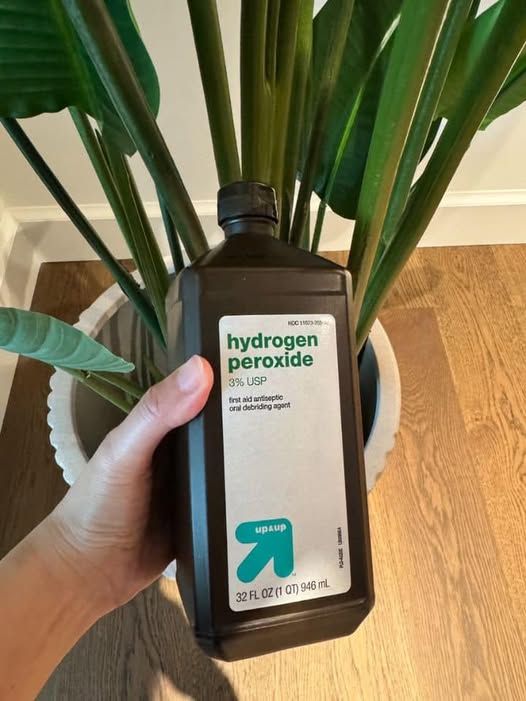ADVERTISEMENT
**Hydrogen Peroxide: A Gardener’s Cure-All. Here’s Why.**
When you think of **hydrogen peroxide**, you might picture it as a handy antiseptic for cleaning wounds or disinfecting surfaces. But did you know that this everyday household item can also be a **game-changer for your garden**? It turns out that hydrogen peroxide (H₂O₂) is a versatile and powerful tool that can promote plant health, prevent diseases, and even improve soil quality.
In this article, we’ll explore why **hydrogen peroxide is a gardener’s cure-all** and how you can use it in various ways to boost the vitality of your garden. Whether you’re an experienced green thumb or just getting started, this simple yet effective solution can make a noticeable difference in your gardening practices.
### **What Is Hydrogen Peroxide?**
Hydrogen peroxide is a chemical compound made up of two hydrogen atoms and two oxygen atoms (H₂O₂). In its pure form, it’s a colorless, odorless liquid, typically available at a concentration of around 3% in most drugstores or grocery stores. Though it’s most commonly used for cleaning and disinfecting, hydrogen peroxide has a wide range of uses in gardening due to its natural properties.
### **Why is Hydrogen Peroxide Good for Your Garden?**
1. **Fights Root Rot and Promotes Healthy Roots**
Root rot is a common problem in gardening, often caused by overwatering, poor drainage, or fungal infections. Plants suffering from root rot can develop yellowing leaves, stunted growth, or wilting, and the roots may become soft and mushy. Hydrogen peroxide can help combat root rot by increasing the oxygen levels in the soil. When added to water, hydrogen peroxide breaks down into water (H₂O) and oxygen (O₂). The extra oxygen helps improve root health and prevent root rot.
#### **How to Use It:**
Mix **one part hydrogen peroxide (3%)** with **two parts water** and water your plants with this solution. This can help aerate the soil and oxygenate the roots, giving them a better chance of surviving and thriving.
2. **Prevents Fungal Diseases**
Fungal diseases like powdery mildew, downy mildew, and blight can wreak havoc on your garden, but hydrogen peroxide is a powerful **fungicide** that can help prevent and treat these issues. The compound’s **oxidizing properties** make it effective at killing harmful fungi without harming the plants.
#### **How to Use It:**
For a natural fungicide, mix **one part hydrogen peroxide (3%)** with **three parts water** and spray it on the affected areas of your plants. Be sure to test the solution on a small part of the plant first to check for any adverse reactions. Regular application can help prevent fungal growth and protect your plants from damage.
3. **Boosts Seed Germination**
Hydrogen peroxide can also aid in **seed germination** by softening the seed coat and encouraging faster sprouting. This is especially helpful for seeds with hard outer shells, such as **morning glories** or **peas**. The extra oxygen helps the seeds break down their hard coatings, giving them the best start possible.
#### **How to Use It:**
Before planting seeds, soak them in a **3% hydrogen peroxide solution** for about 30 minutes. This will help break down the seed coat, speed up germination, and improve your chances of a successful crop.
4. **Helps with Plant Pest Control**
Hydrogen peroxide is a natural solution for controlling pests in the garden, especially **aphids**, **spider mites**, and **mealybugs**. It can be used to kill insects on contact, while also acting as a **natural cleaner** to remove any pest residues from the leaves and stems of your plants.
#### **How to Use It:**
To make an insecticidal spray, mix **one part hydrogen peroxide (3%)** with **three parts water**. Spray it directly onto the leaves and stems where pests are visible. Repeat the treatment every few days until the pest problem is under control. Be cautious when applying it to new or sensitive plants, as hydrogen peroxide can be harsh on them if used in excess.
5. **Improves Soil Aeration**
Soil that lacks proper oxygen can become compacted and may hinder root growth, leading to poor plant health. By adding hydrogen peroxide to the soil, you introduce extra oxygen, which helps to **aerate** the soil and improve its texture. This is especially helpful in clay-heavy or poorly draining soils.
**How to Use It:**
Mix **one cup of hydrogen peroxide (3%)** into **one gallon of water** and water your plants with this solution. This helps to break up compacted soil, allowing for better root growth and improved drainage.
For Complete Cooking STEPS Please Head On Over To Next Page Or Open button (>) and don’t forget to SHARE with your Facebook friends
ADVERTISEMENT
